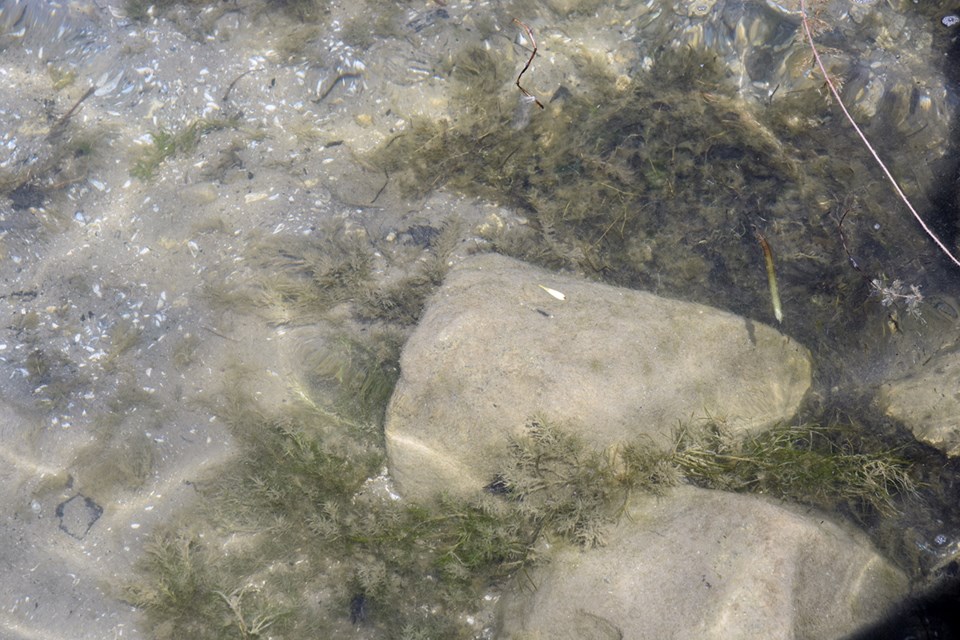In 2006, floating mats of rotting waterweeds washed up along the Lake Simcoe shoreline in Cook’s Bay, leading to complaints from property owners, boaters and swimmers. The Town of Georgina alone reportedly spent $200,000 that year, harvesting and removing excess weeds from recreational areas.
It was all blamed on an aquatic invader: Myriophyllum spicatum, the Eurasian water-milfoil.
Eurasian water-milfoil looks harmless - in an aquarium. The feathery leaves, arranged in whorls around the submerged stem, create a kind of miniature forest through which aquarium fish dart. But out in nature, the plant becomes invasive, forming dense mats that crowd out native species, interfere with swimming, boating and other aquatic activities; and can reduce oxygen levels in the lake, when the plants die back and decompose.
Actually, the reality is not that simple, said Lake Simcoe Region Conservation Authority Limnologist, Brian Ginn. At least in Lake Simcoe, Eurasian water-milfoil appears to be finding a balance in the evolving ecology of the lake – supplanting or hybridizing with the native milfoil, it now provides habitat for young fish and invertebrates, calms wave action along the shore – reducing erosion, and serves as a food source for waterfowl and insects.
The last survey of Lake Simcoe’s aquatic plants found that the native species Coon-tail (Ceratophyllum) made up 34.5 per cent of the biomass, muskgrass (Chara) made up 19 per cent - and Eurasian water-milfoil was the second-most abundant, at 21 per cent.
In Cook’s Bay, plant biomass increased by about 40 per cent, from 2008 to 2014 – thanks to another type of invasive species in the lake: two filter feeders. The presence of Zebra mussels, introduced in the 1990s, and quagga mussels, first detected in 2004, led to increased water clarity, allowing sunlight to penetrate to a greater depth – and aquatic plants to spread.
Eurasian water-milfoil generally prefers shallow water, up to three metres in depth, but can occur at depths of up to 10 metres where the water is clear.
The plant only becomes a real problem when nutrient levels in the lake are high, leading to excessive growth – so controlling phosphorus inputs into the lake is one of the best ways to curb the growth of milfoil, Ginn said.
Although it becomes a “nuisance” when the mats of vegetation wash up on shore, Ginn argued it was all part of a natural cycle in the lake that actually supports biodiversity. Instead of sinking to the bottom, the dead plants are blown by the prevailing winds and wash up on the shoreline. It may be unsightly, but the rotting weeds become food for insects and other invertebrates as they decompose, and eventually food for fish.
“It’s kind of a natural cycle, as disgusting as it seems,” Ginn said.
If property owners feel the need to remove the decomposing aquatic plants from the shore, he recommended composting. “It’s high in phosphorus,” he said – another benefit of the invader, which is effective at taking up and trapping the nutrient.
As the name suggests, Eurasian water-milfoil is native to Eurasia and northern Africa. It made its way to North America in the 19th century, probably in the ballast water of ships – but a finger has also been pointed at the aquarium trade. Released into the wild, either accidentally or deliberately, water-milfoil has spread – to the point that, according to Ontario’s Invading Species Awareness Program, it is “one of the most widely distributed aquatic plants on the continent.”
It has the perfect strategy for a successful invasion. Every plant fragment – broken off by swimmers, anglers or boaters – can drift and root in a new location.
The spread of Eurasian water-milfoil has led to recommendations that make sense when it comes to controlling the spread of any invasive:
. Boaters should take care not to snag and transport the weed, and should clean off water weeds and animals from boats, trailers and other gear after every use - especially before moving to a new water body. Drain all water, and dry the boat and motor well before they are moved.
. Never release aquarium stock, either plants or animals, into the wild. Return to the pet store or destroy – do not discard in natural areas.
. When buying plants for a garden, water garden or aquarium, ask the supplier for a native alternative to a potentially invasive species.
. If you spot Eurasian water-milfoil or any other invasive in the wild, call the Invading Species Hotline, 1-800-563-7711 or report to www.invadingspecies.com or ontarioinvasiveplants.ca or to the Early Detection & Distribution Mapping System, www.eddmaps.org/ontario.
The LSRCA conducts a survey of aquatic plants in Lake Simcoe every five years. Ginn was out on the Hexagenia, the conservation authority’s research vessel, earlier this month, sampling the aquatic biomass.
The results have been shocking, and identified a new invasive problem.
In 2013, Eurasian water-milfoil was extensively distributed throughout Cook’s Bay. ”The good news is it’s down,” said Ginn. The bad news? “It’s just being replaced by something worse. Cook’s Bay is all starry stonewort.”



